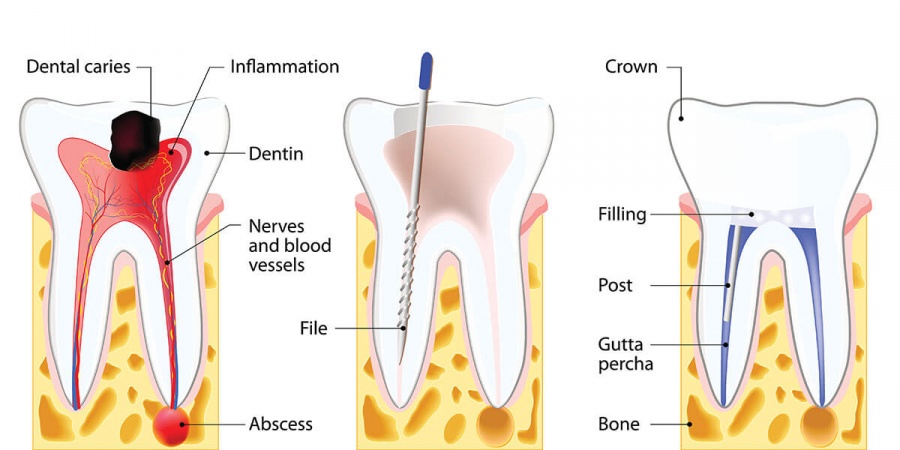
Root canal treatment is one of the most popular dental procedures carried out in the US, successful in over 90% of cases. This is an effective, painless way to save a tooth that has become infected or damaged, and might otherwise require extraction. Performing a root canal procedure preserves and restores the tooth, ensuring it is free of infection, as well as stable and secure in the gum. A root canal treatment, performed in time, will prevent the need for costly dental treatment to replace the tooth.
Sometimes bacteria developing through plaque and tartar build-up, can lead to an infection occurring inside a tooth. The pulp can become inflamed and affected by decay, trauma, or through a crack allowing infection to enter the tooth. The pulp lies at the heart of the tooth, managing the flow of blood through vessels that feed the tooth. Roots of the tooth travel up into the base of the pulp. A root canal treatment carefully opens the tooth from the top or the back, to remove damaged tissue, and fills the space with sterile and durable material, thus anchoring the tooth in the gum.
Patients don’t usually know they need a root canal, though they probably know it’s time to see a dentist. Infection leading to the need for treatment will often become painful; alerting the patient that something is in need of attention.

Symptoms can include: localized pain on a specific tooth or part of the mouth; heightened sensitivity to cold and hot drinks, and even sweet and spicy foods. You may also experience swelling or redness in the face and gum.
If you feel any of these symptoms, call us at once, as infections starting in the tooth can easily spread to other parts of the body:
SWOLLEN MOUTH OR CHEEK
HIGHLY SENSITIZED PAIN AROUND THE TOOTH AND GUM
INFLAMMATION IN THE GUM OR MOUTH TISSUE
FEVER
PAIN WHEN BITING OR CONSUMING BEVERAGES
BAD TASTE OR ODOR
Root canal treatment had some bad PR in the past, though it’s actually a very straightforward and painless process. Root canal treatment takes away the causes of infection which produce pain. Results of one study revealed that patients who had received a root canal treatment, reported it caused no more discomfort than a filling, while those who had not undergone the treatment, anticipated it would cause considerable pain.
As soon as you experience toothache or oral pain of any kind, get in touch. We can assess and diagnose the problem right away, so that treatment can commence as soon as possible.
The problems leading to root canal are common, and your dentist may recognize your symptoms, though they will perform a complete dental check and take x-rays, to determine the exact nature of your discomfort.
After a full dental exam is complete and x-rays have been taken, the dentist will decide if your treatment can be carried out in-house. More complicated cases require the attention of an endontologist. This is a dental practitioner specializing in the root and the pulp, which holds blood vessels supporting the teeth. An endontologist will review your x-rays and the dentist’s diagnosis. A complete oral check will be performed, and if necessary, additional x-rays taken.
The infected tooth and surrounding area will be numbed fully, and for patients with added anxieties, nitrous oxide analgesia can also be administered for relaxation. Once the area is fully numbed and the patient is comfortable, the top or back of the tooth will be opened with a drill, and the root accessed for cleaning. All of the infected pulp will be removed with special tools designed to access the small space and carry out work successfully.
The root system will be cleaned and dead tissue removed. Once all of the infected matter is cleared and the cavity cleaned, the area is irrigated and made sterile. Depending upon the degree of infection in the tooth, the endontologist may require you return for a second appointment. If this is necessary, a temporary cover will be placed on the tooth to ensure it is sealed and protected from further infection until the treatment is completed. Antibiotics may be prescribed to combat infection, which can spread to other parts of the mouth or body if left untreated. In the space left by the infected tissue, a substance called ‘gutta percha’ is inserted to fill the void. This is a rubber-like substance with medicated properties. Once fully set in place, gutta percha hardens and supports the tooth firmly, ensuring its stability in the gum line.
Your dentist or endontologist will close the tooth when the treatment is complete, sealing it with a cap. This will protect the tooth and allow it to settle and recover until any cosmetic treatment, such as a crown or bridge is ready to be attached.
The alternative to root canal is losing the tooth. When a tooth becomes infected, the pulp and root of the tooth die. Without treatment the tooth will lose its hold in the gum and ultimately, fall out. This may take some time, allowing infection to spread, and potentially causing considerable pain.
When the patient neglects to undergo treatment to save the tooth, they face living with the space created, or opting for a tooth replacement solution, such as an implant, crown, or denture to conceal the gap. Root canal treatment is the favored method of saving a tooth that’s died, before costly replacements become the only alternative.
After treatment, the endontologist will send a record of your treatment, detailing the procedure performed. After 2-3 weeks, when the area has fully healed, your dentist can resume treatment, to add a permanent cap or crown to your newly restored tooth. Not all teeth require a crown or cap after root canal treatment, though this will strengthen the tooth and prolong its lifespan.